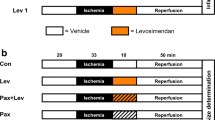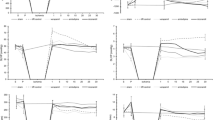Abstract
The protective effects of sarpogrelate (SG), a 5-HT2A antagonist, were investigated in perfused guinea-pig Langendorff hearts subjected to ischemia and reperfusion. Changes in cellular levels of high phosphorous energy, NO and Ca2+ in the heart together with simultaneous recordings of left ventricular developed pressure (LVDP) were monitored using an nitric oxide (NO) electrode, fluorometry and 31P-NMR. The recovery of LVDP from ischemia by reperfusion was 30.1% in the control, while the treatment with SG (5×10-7 M) in pre- and post-ischemia hearts produced a gradual increase to 73.1 and 53.6%, respectively. At the final stage of ischemia, the intracellular concentration of Ca2+ ([Ca2+i) and release of NO increased with no twitching and remained at a high steady level. The addition of SG increased the transient NO signal (TNO) level at the end of ischemia compared with the control, but [Ca2+]i during ischemia decreased. Meanwhile, mitochondrial Ca2+ uptake on acidification or Ca2+ content changes of the perfusate was suppressed by pre-treatment with SG or the KATP channel opener diazoxide, but not the KATP channel blocker 5-HD. The myocardial NO elevated with 5-HT in normal Langendorff hearts was suppressed by the treatment with SG. Therefore, the existence of the 5HT2A receptor in a Langendorff heart was anticipated. By in vitro EPR, SG was found to directly quench the hydroxy radical. Thus, these findings suggested that the 5-HT2A receptor induced in ischemia–reperfusion plays an important role in the mitochondrial KATP channel of hearts in close relation with NO and active oxygen radicals.
Similar content being viewed by others
References
Frishman WH, Huberfeld S, Okin S, Wang YH, Kumar A, Shareef B: Serotonin and serotonin antagonism in cardiovascular and non-cardiovascular disease. J Clin Pharmacol 35: 541–572, 1995
Parikh V, Singh M: Resident cardiac mast cells and the cardioprotective effect of ischemic preconditioning in isolated rat heart. J Cardiovasc Pharmacol 30: 149–156, 1997
Vikenes K, Farstad M, Nordrehaug JE: Serotonin is associated with coronary artery disease and cardiac events. Circulation 100: 483–489, 1999
Frishman WH, Grewall P: Serotonin and the heart. Ann Med 32: 195–209, 2000
Saxena PR: Cardiovascular effects from stimulation of 5-hydroxytryptamine receptors. Fund Clin Pharmacol 3: 245–265, 1989
Nilsson T, Longmore J, Shaw D, Pantev E, Bard JA, Branchek T, Edvinsson L: Characterization of 5-HT receptors in human coronary arteries by molecular and pharmacological techniques. Eur J Pharmacol 372: 49–56, 1999
Fozard JR, Mwaluko GM: Mechanism of the indirect sympathomimetic effect of 5-hydroxytryptamine on the isolated heart of the rabbit. Br J Pharmacol 57: 115–125, 1976
Sakai K, Akima M: An analysis of the stimulant effects of 5-hydroxytryptamine on isolated, blood-perfused rat heart. Eur J Pharmacol 55: 421–424, 1979
Hamamori Y, Yokoyama M, Yamada M, Akita H, Goshima K, Fukuzaki H: 5-hydroxytriptamine induces phospholipase C-mediated hydrolysis of phosphoinositides through 5-hydroxytryptamine-2 receptors in cultured fetal mouse ventricular myocytes. Circ Res 66: 1474–1483, 1990
Laer S, Remmers F, Scholz H, Stein B, Muller FU, Neumann J: Receptor mechanisms involved in the 5-HT-induced inotropic action in the rat isolated atrium. Br J Pharmacol 123: 1182–1188, 1998
Spigset O, Mjorndal T: Serotonin 5-HT2A receptor binding in platelets from healthy subjects as studied by [3H]-lysergic acid diethylamine ([3H]-LSD): intra- and interindividual variability. Neuropysychopharmacology 16: 285–293, 1997
Barnes NM, Sharp T: A review of central 5-HT receptors and their function. Neurophamacology 38: 1083–1152, 1999
Shigei T, Ishikawa N, Ichikawa T, Tsuru H: Differences in the response of three embryologically distinct segments of the isolated canine posterior vena cava to vasoactive substances. Blood Vessels 15: 157–169, 1978
Cerrito F, Lazzaro MP, Gaudio E, Armino P, Aloisi G: 5-HT2-receptors and serotonin release: their role in human platelet aggregation. Life Sci 53: 209–15, 1993
Hara H, Osakabe M, Kitajima A, Tamao Y, Kikumoto R: MCI-9042, a new antiplatelet agent, is a selective S2-serotonergic receptor antagonist. Thromb Haemost 65: 415–420, 1991
Niwa M, Kunisada K, Himeno A, Kawaguchi A, Ozaki M: 5-hydroxytryptamine content in the rat heart: Quantitation by high-performance liquid chromatographic electrochemical detection. Jpn J Pharmacol 34: 264–267, 1984
Shimizu Y, Minatoguchi S, Hashimoto K, Uno Y, Arai M, Wang N, Chen X, Lu C, Takemura G, Shimomura M, Fujiwara T, Fujiwara H: The role of serotonin in ischemic cellular damage and the infarct size-reducing effect of sarpogrelate, a 5-hydroxytryptopamine-2 receptor blocker, in rabbit hearts. J Am Coll Cardio 140: 1347–1355, 2002
Teramoto Y, Urano T, Nagai N, Takada Y, Ikeda K, Takada A: Plasma levels of 5-HT and 5-HIAA increased after intestinal ischemia/reperfusion in rats. Jpn J Physiol 48: 333–339, 1998
Van den Berg EK, Schmitz JM, Benedict CR, Malloy CR, Willerson JT, Dehmer GJ: Transcardiac serotonin concentration is increased in selected patients with limiting angina and complex coronary lesion morphology. Circulation 79: 116–124, 1989
Brogden RN, Sorkin EM: Ketanserin. A review of its pharmacodynamic and pharmacokinetic properties, and therapeutic potential in hypertension and peripheral vascular disease. Drugs 40: 903–949, 1990
Grover GJ, Sargent GA, Dzwonczyk S, Normandin DE, Antonaccio NJ: Protective effect of serotonin (5-HT2) receptor antagonists in ischemic rat hearts. J Cardiovasc Pharmacol 22: 664–672, 1993
Grover GJ, Parham CS, Youssef S, Ogaletree ML: Protective effect of the serotonin receptor antagonist cinanserin in two canine models of pacing-induced myocardial ischemia. Pharmacology 50: 286–297, 1995
Hotta Y, Nagatsu A, Liu W, T Muto, Narumiya C, Lu X, Yajima M, Ishikawa N, Kawai N, Mizukami H, Sakakibara J : Protective effects of serotonin derivatives isolated from safflower against postischemic myocardial dysfunction. Mol cell Biochem 238: 151–162, 2002
Hotta Y, Fujita M, Nakagawa J, Ando H, Takeya K, Sakakibara J: Contribution of cytosolic ionic and energetic milieu change to ischemia- and reperfused-induced injury in guinea-pig heart: Fluorometry and nuclear magnetic resonance studies. J Cardiovasc Pharmacol 31: 146–56, 1998
Hotta Y, Nakagawa J, Wakida Y, Ishikawa N, Ando H, Takeya K, Ohashi N, Matsui K: Protective effect of SM-20550, a selective Na+-H+ exchange inhibitor, on ischemia–reperfusion injured hearts. J Cardiovasc Pharmacol 37: 143–154, 2001
Hotta Y, Ishikawa N, Ohashi N, Matsui K: Effects of SM-20550, a selective Na+-H+ exchange inhibitor, on the ion transport of myocardial mitochondria. Moll Cell Biochem 219: 83–90, 2001
Hotta Y, Nishimaki H, Takeo T, Itoh G, Yajima M, Otsuka-Murakami H, Ishikawa N, Kawai N, Huang L, Yamada K, Yamamoto S, Matsui K, Ohashi N: Differences in the effects of Na+-H+ exchange inhibitors on cardiac function and apoptosis in guinea-pig ischemia-reperfused hearts. Eur J Pharmacol 503: 109–122, 2004
Ozaki H, Satoh T, Karaki H, Ishida Y: Regulation of metabolism and contraction by cytoplasmic calcium in the intestinal smooth muscle. J Biol Chem 264: 14074–14079, 1988
Ichimori K, Ishida H, Fukabori M, Nakazawa H, Murakami E: Practical nitric oxide measurement employing a nitric oxide-sensitive electrode. Rev Sci Instrum 65: 1–5, 1994
Cao Y, Hotta Y, Shioi K, Nagata Y, Kawai N, Ishikawa N: Protective effects of FK409, a novel NO-donor, against post-ischemic myocardial dysfunction in guinea-pig hearts. J Cardiovasc Pharmacol 38: 593–605, 2001
Higuchi H, Satoh T: Endothelin-1 induces vasoconstriction and nitric oxide release via endothelin ET B receptors in isolated perfused rat liver. Eur J Pharmacol 328: 175–182, 1997
Hotta Y, Otsuka-Murakami H, Fujita M, Nakagawa J, Yajima M, Ishikawa N, Kawai N, Masumizu T, Kohno M: Protective role of nitric oxide synthase in myocardial mitochondria against ischemia–reperfusion injury in guinea pigs. Eur J Pharmacol 380: 37–48, 1999
Temsah RM, Kumamoto H, Takeda N, Dhalla NS: Sarpogrelate diminishes changes in energy stores and ultrastructure of the ischemic-reperfused rat heart. Can J Physiol Phamacol 79: 761–767, 2001
Brasil D, Temsah RM, Kumar K, Kumamoto H, Takeda N, Dhalla NS: Blockade of 5-HT2A receptors by sarpogrelate protects the heart against myocardial infarction in rats. J Cardiovasc Pharmacol Therapeut 7: 53–59, 2002
Tani M, Neely JR: Role of intracellular Na+ in Ca2+ overload and depressed recovery of ventricular function of reperfused ischemic rat hearts. Circ Res 65: 1045–1056, 1989
Brooks, WW, Conrad, CH, Morgan, JP: Reperfusion induced arrhythmias following ischemia in intact rat heart: Role of intracellular calcium. Cardiovasc Res 29: 536–542, 1995
Koike A, Abe T, Hotta Y, Takeya K, Kodama I, Toyama J: Protective effects of dimethyl amiloride, a potent Na+-H+ exchange inhibitor, against post-ischemic myocardial dysfunction. 31P-NMR measurements of pHi and cellular energy in isolated perfused rabbit hearts. J Thorac Cardiovasc Surg 112: 765–775, 1996
Ishida H, Higashijima N, Hirota Y, Genka C, Nakazawa H, Nakaya H, Sato T: Nicorandil attenuates the mitochondrial Ca2+ overload with accompanying depolarization of the mitochondrial membrane in the heart. Naunyn Schmiedebergs Arch Pharmacol 369: 192–197, 2004
Vanhoute P, Shimokawa H: Endothelium-derivatived relaxing factor and coronary vasospasm. Circulation 80: 1–9, 1989
Chacon E, Acosta D: Mitochondrial regulation of superoxide by Ca2+: An alternate mechanism for the cardiotoxicity of doxorubicin. Toxicol Appl Pharmacol 107: 117–28, 1991
Paraidathathu T, de Groot H, Kehrer JP: Production of reactive oxygen by mitochondria from normoxic and hypoxic rat heart tissue. Free Radic Biol Med 13: 289–297, 1992
Author information
Authors and Affiliations
Corresponding author
Rights and permissions
About this article
Cite this article
Muto, T., Hotta, Y., Miyazeki, K. et al. Protective effects of sarpogrelate, a 5-HT2A antagonist, against postischemic myocardial dysfunction in guinea-pig hearts. Mol Cell Biochem 272, 119–132 (2005). https://doi.org/10.1007/s11010-005-6909-0
Received:
Accepted:
Issue Date:
DOI: https://doi.org/10.1007/s11010-005-6909-0




